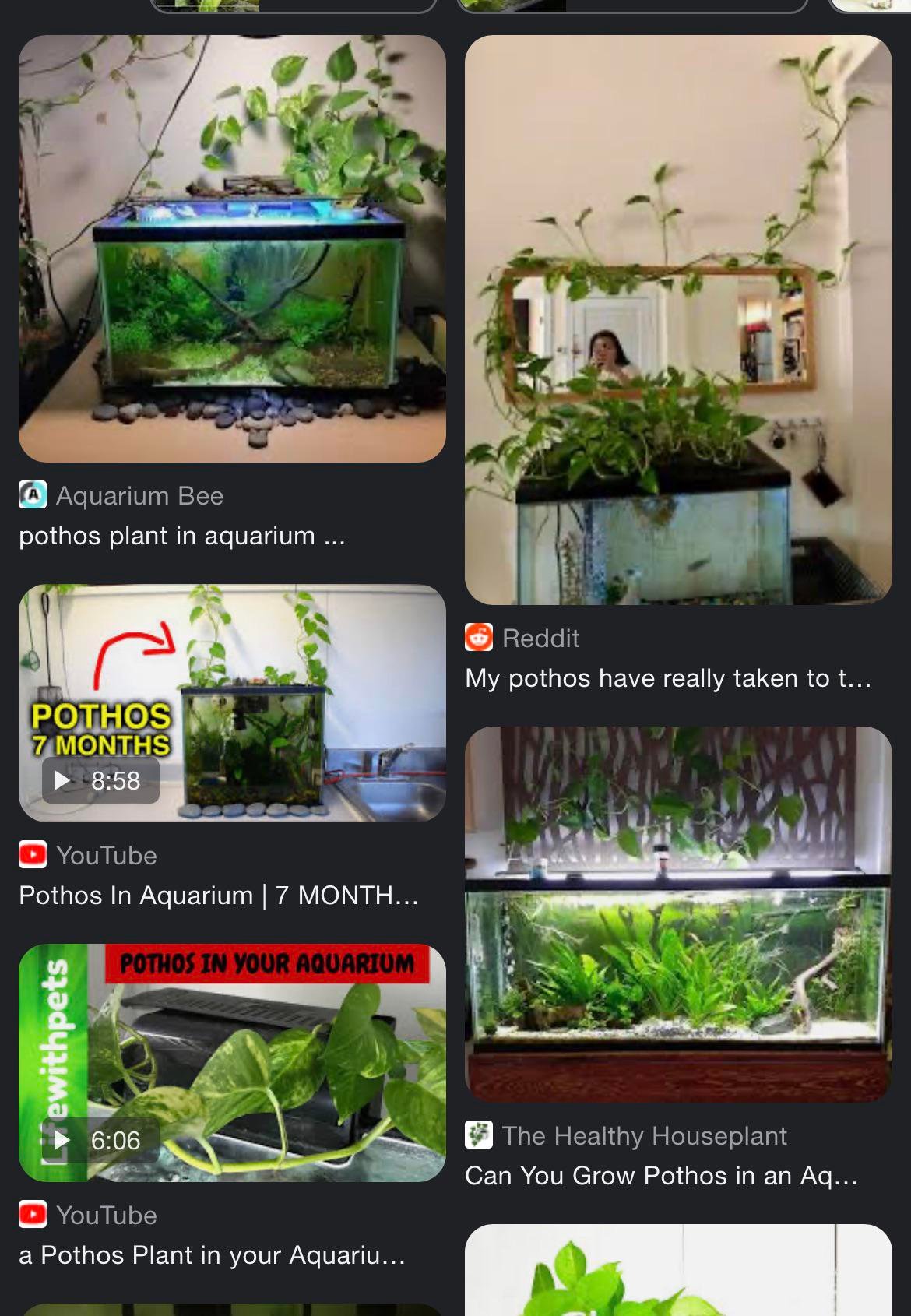Aquarium plants can greatly enhance the beauty of your fish tank. But, not all plants are safe for fish.
Some can be harmful or even deadly to your aquatic pets. When setting up your aquarium, choosing the right plants is crucial. Safe plants not only create a natural habitat but also provide hiding spots and improve water quality. They can help reduce stress for fish and offer a more vibrant environment.
Many fish enthusiasts face the challenge of selecting safe plants. This guide will help you understand which plants are beneficial and safe. By the end, you’ll know exactly which plants to choose, ensuring a healthy and thriving aquarium for your fish.

Credit: www.reddit.com
Introduction To Aquarium Plants
Aquarium plants add beauty and function to your fish tank. They create a natural environment for your fish. These plants help maintain water quality and provide shelter. Fish feel more at home in a well-planted aquarium. Let’s dive into the world of aquarium plants and their benefits.
Benefits Of Live Plants
Live plants offer many advantages in an aquarium. They produce oxygen, which helps fish breathe. Plants also absorb carbon dioxide and harmful toxins. This keeps the water clean and healthy. Live plants reduce algae growth by competing for nutrients. They create a natural habitat that reduces fish stress. Plants provide hiding places for shy or small fish. This promotes natural behavior and improves fish health.
Common Types Of Aquarium Plants
There are many types of aquarium plants. Some popular choices include Anubias, Java Fern, and Amazon Sword. Anubias are hardy and easy to care for. They grow well in low light conditions. Java Fern is another low-maintenance plant. It attaches to rocks or driftwood. Amazon Sword plants are larger and need more light. They create a lush, green backdrop in your tank. Other options include Cryptocoryne, Hornwort, and Vallisneria. Each plant type has unique care requirements. Choose plants that match your tank conditions and fish species.
Choosing Safe Plants
When setting up an aquarium, choosing safe plants for your fish is crucial. Safe plants not only enhance the tank’s beauty but also ensure the well-being of your aquatic pets. Some plants can be harmful, so it’s important to know which ones to select.
Non-toxic Plants
Java Fern is a popular choice. It’s easy to care for and non-toxic. Fish love to swim around its leaves. Another great option is Anubias. It’s hardy and grows well in different conditions. Your fish will enjoy hiding among its broad leaves.
Amazon Sword is also safe. It grows tall and provides good cover for fish. This plant thrives in most aquariums. Moss Balls are fun and safe too. Fish play with them and they help keep the water clean.
Avoiding Harmful Species
Some plants can harm your fish. Avoid plants like Pothos. Its leaves can be toxic if fish nibble on them. Duckweed can also be problematic. It grows fast and can block light, affecting other plants and fish.
Another harmful plant is Water Hemlock. It’s very toxic. Keep it out of your tank. Also, avoid Hydrilla. It can overtake your tank quickly and disrupt the balance.
Always research plants before adding them to your aquarium. This ensures a safe and healthy environment for your fish.
Popular Safe Plants
Choosing the right plants for your aquarium is essential. Many aquarium plants are safe for fish and enhance the tank’s beauty. In this section, we will explore some popular safe plants for your aquarium. These plants not only provide shelter and oxygen but also create a natural habitat for your fish.
Java Fern
Java Fern is a popular choice among aquarists. It is hardy and easy to maintain. This plant thrives in various water conditions. Java Fern does not need high light. You can attach it to rocks or driftwood. It provides excellent hiding spots for fish.
Anubias
Anubias is another safe plant for fish tanks. It grows slowly and needs low light. This plant can be attached to rocks or wood. Anubias has broad, dark green leaves. These leaves offer shade and shelter for fish. Anubias is also resistant to most fish nibbling.
Cryptocoryne
Cryptocoryne is a versatile aquarium plant. It comes in various shapes and colors. This plant grows well in low to moderate light. Cryptocoryne can be planted in the substrate. It creates dense foliage, perfect for fish to hide. This plant adapts well to different water conditions.

Credit: www.reddit.com
Plant Maintenance
Aquarium plants like Java Fern, Anubias, and Amazon Sword are safe for fish. These plants provide shelter and improve water quality.
Keeping aquarium plants healthy involves proper maintenance. Healthy plants create a better environment for fish. Regular care ensures they thrive and stay beautiful.Proper Lighting
Proper lighting is crucial for plant health. Plants need light to produce food through photosynthesis. Without enough light, they can wither and die. LED lights are a good choice. They provide the right spectrum and are energy-efficient. Place the lights above the tank for optimal coverage. Monitor the light duration. Around 8 to 10 hours of light per day is ideal.Nutrient Requirements
Aquarium plants need nutrients to grow. They absorb nutrients from water and substrate. Essential nutrients include nitrogen, phosphorus, and potassium. Liquid fertilizers can supply these nutrients. Add them according to the instructions. Substrate fertilizers are also beneficial. They provide a steady nutrient supply to the plant roots. Regular water changes help maintain nutrient balance. Remove dead leaves to prevent decay and nutrient depletion. “`Plant And Fish Compatibility
Choosing the right aquarium plants is crucial. Plants and fish must coexist peacefully. Some fish species eat plants. Others may damage them. Therefore, plant and fish compatibility is essential. This guide will help you understand which plants are safe for your fish.
Plant-eating Fish
Some fish love to eat plants. Goldfish and cichlids are known plant-eaters. If you have these fish, avoid delicate plants. Choose hardier options. Anubias and Java Fern are good choices. They have tough leaves. These plants can withstand nibbling.
Safe Plants For All Fish
Some plants are safe for all fish types. They are hardy and resilient. Java Moss is a popular choice. It grows fast and is easy to maintain. Another good option is Amazon Sword. It provides good hiding spots. Fish feel safe among its leaves.
Cryptocoryne is also a safe plant. It adapts well to various conditions. Fish do not usually eat it. These plants help maintain a healthy aquarium. They improve water quality. They also provide oxygen. Choosing the right plants ensures happy fish and a beautiful tank.

Credit: www.youtube.com
Aquascaping Tips
Creating a beautiful and healthy aquarium involves more than just adding plants and fish. Aquascaping is the art of arranging aquatic plants, rocks, and driftwood in a balanced and visually pleasing way. These tips will help you create a stunning underwater world that is safe for your fish.
Creating A Balanced Ecosystem
A balanced ecosystem keeps fish and plants healthy. Start by choosing a variety of plants. Include fast-growing and slow-growing species. Fast-growing plants absorb excess nutrients and help prevent algae. Slow-growing plants add stability and beauty.
Ensure your plants and fish have similar needs. Research their preferred water conditions. This includes temperature, pH, and hardness. Provide adequate lighting for your plants. Good lighting helps photosynthesis and plant growth. Use a reliable aquarium filter. It keeps the water clean and provides oxygen.
Aesthetic Arrangements
Arrange plants to mimic natural environments. Place taller plants at the back. This creates depth and makes your aquarium look larger. Use mid-sized plants in the middle. They add layers and interest. Place small plants and ground covers at the front. This gives a neat and tidy look.
Combine different colors and textures. This makes your aquarium more appealing. Use driftwood and rocks as focal points. They add structure and hideouts for fish. Avoid overcrowding. Leave enough space for fish to swim freely.
Regular maintenance is key. Prune plants to keep them in shape. Remove any dead leaves or algae. This keeps your aquarium looking fresh and clean.
Troubleshooting Plant Issues
Keeping a healthy aquarium involves more than just taking care of fish. Plants play a crucial role in maintaining the balance of the tank. But sometimes, you might face issues with your aquarium plants. This section will help you identify and solve common plant problems.
Common Problems
Even with the right setup, aquarium plants can face various problems. Here are some typical issues:
- Yellowing leaves: Often caused by nutrient deficiencies.
- Algae overgrowth: Can suffocate plants and harm fish.
- Stunted growth: May result from poor lighting or lack of CO2.
- Melting plants: Plants disintegrate and disappear, usually from sudden changes in water conditions.
- Holes in leaves: Can be due to nutrient imbalances or fish nibbling.
Effective Solutions
Each problem has specific solutions to restore your plants’ health. Here are some effective ways to tackle these issues:
| Problem | Solution |
|---|---|
| Yellowing leaves | Add fertilizers rich in iron and potassium. |
| Algae overgrowth | Reduce light exposure and increase water changes. |
| Stunted growth | Ensure adequate lighting and CO2 levels. |
| Melting plants | Gradually acclimate plants to new water conditions. |
| Holes in leaves | Check for nutrient imbalances and monitor fish behavior. |
Regular maintenance and monitoring can prevent most plant issues. Always check water parameters and provide proper care to keep your aquarium plants healthy and safe for your fish.
Frequently Asked Questions
What Are The Best Aquarium Plants For Beginners?
The best aquarium plants for beginners are Java Fern, Anubias, and Amazon Sword. These plants are low maintenance, easy to grow, and do not require high light or CO2.
Are Live Plants Safe For Fish?
Yes, live plants are safe for fish. They provide oxygen, reduce nitrates, and offer hiding spots. They also help maintain a healthy environment for fish.
Do Aquarium Plants Need Special Lighting?
Most aquarium plants need moderate lighting. However, some plants like Java Fern and Anubias can thrive in low light conditions. Always check the specific light requirements.
How Do I Clean Aquarium Plants?
Clean aquarium plants by gently rinsing them with dechlorinated water. Remove any dead leaves and check for pests. Avoid using soap or chemicals.
Conclusion
Choosing safe aquarium plants benefits both fish and tank health. Popular options include Java Fern, Anubias, and Amazon Sword. These plants provide shelter and enhance water quality. Always research plant needs before adding them. Proper care ensures plants thrive and support fish well-being.
Happy fishkeeping!





